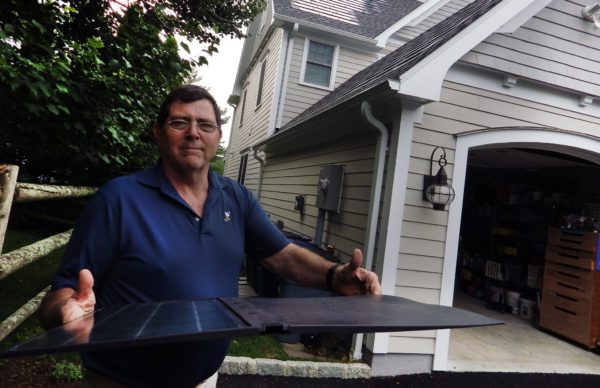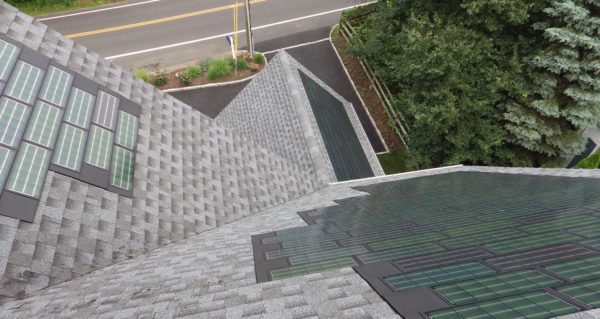Solar shingles usher in ‘next phase’ for energy saving
In their first six months online, the solar shingles atop an Old Greenwich home have saved nearly a barrel of oil total, or $182 per month, compared with standard usage.
The low-profile shingles represent a coming “next phase” for solar energy that the home”™s owner ”” Chris Murphy, also its builder ”” said is seeing sleeker products and advances like prefabricated solar panels fitted into building faces. Passive solar has long thawed icy drives, but there could come a day when driveway pavers will become power-generating dynamos. “Even paint,” he said, will one day power wall sockets.
Murphy is principal, along with his brother Sean, of Mamaroneck, N.Y.-based Murphy Brothers Contracting Inc. He built the house in which he and his family now live on Shore Road with foam forms and poured concrete and with a plan to incorporate solar shingles.
The biggest advance in home solar technology, Murphy said, is aesthetic, since solar shingles eliminate the higher-profile solar elements that have become familiar fixtures on roofs.
The Shore Road garage holds a turntable-sized inverter ”” made by Dow, which also made the Powerhouse brand of shingles on the roof ”” that converts direct current made by the shingles to alternating current usable by appliances and lights.
Two manufacturers ”” Dow and CertainTeed ”” dominate the field now, according to CleanTechnica, a green tech Web clearinghouse of news and analysis. “But new competitors include GAF and Corning, plus a slew of Chinese manufactures,” the company said.
“We make every effort for clients who want to invest in the latest technology,” said Murphy. He said his company”™s marketing of solar shingles is a regional first. “The future is ripe and energy efficiency is a big deal. Anything you can do that makes things more energy-efficient, you”™re going to have a market.”
About 10 percent of Murphy Brothers”™ clients opt for solar power, but 100 percent get the offer, he said.
Murphy Brothers partners with Norwalk-based research and consulting firm Steven Winter Associates Inc. to teach architects about the latest technological developments in energy efficiency and production (and, recently, in developments to prevent hundreds of millions of birds from flying into glass buildings every year).
Winter specializes in “technologies and procedures that improve the performance and cost effectiveness of buildings” and together, Murphy said, they teach the recipe makers. “We rely on the architects for the recipe. The house is the cake. So we”™ve been promoting continuing education for architects for the last four or five years. They make the recipe; we make the cake.”
“Corporations are far ahead of the home sector with solar use,” said Michael Murphy, no relation to Sean and Chris and head of new project development for Murphy Brothers Contracting. “It saves money and demonstrates environmental responsibility. Places like box stores are now very conscious of their energy use. Some have begun using fuel cell technology.”
“It”™s driving a conversation that includes large buildings using no energy or producing more energy than they use,” Chris Murphy said. Energy conservation and Leadership in Energy and Environmental Design considerations are a must for all government building construction contracts, he said.
Solar regionally is hampered by three factors, Murphy said.
”¢ Big trees: “They”™re beautiful and they provide shade. But they often block the southern exposure.”
”¢ Peak of the pitch: “Many houses here have steep pitches that can limit their ability to be effective.”
”¢ Orientation: “Houses are generally required to orient their fronts to the street. This is common in towns.”
The critical elements of roof pitch and road exposure are best handled beginning with the design phase, Murphy said, a la broad estate layouts in the Sun Belt.
“Here, You have to find your solar,” he said.
Murphy said a solar-shingle roof costs about $20,000, but Connecticut offers incentives that will help pay it off in seven years. New York will help a homeowner pay off a solar roof in four years. The Dow shingles he used have a 20-year warranty.
Installing traditional solar panels on the same roof would cost about the same or slightly less, but using solar shingles eliminates the cost of conventional shingles, Michael Murphy cited a Dow sales representative as saying.
The company is also using solar shingles on its new 40,000-square-foot storage facility ”” Mamaroneck Self Storage ”” adjacent to its headquarters at 560 Fenimore Road. The building was topped in April and is accepting leasing applications.


